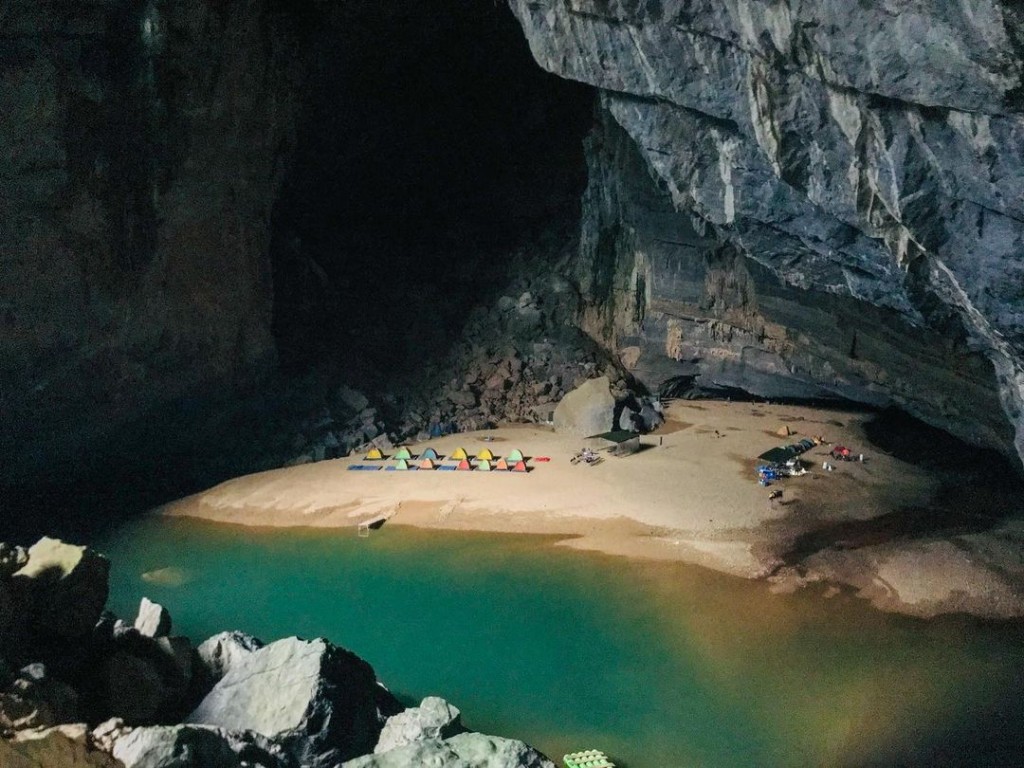The park is located in Quang Binh province, and is home to some of the most stunning karst formations in the world. It is famous for its towering limestone mountains, lush rainforests, and breathtaking underground rivers. A total of 300 caves have been discovered so far, with the most famous one being Son Doong Cave, which was recently declared the world’s largest cave. Visitors to the park can explore the caves, trek through the dense jungle, and even swim in the beautiful rivers.
Phong Nha–Ke Bang National Park is a unique destination that has something for everyone. Whether you’re looking for a thrilling adventure or a peaceful getaway, it’s the perfect place to visit. With its stunning landscape, fascinating wildlife, and incredible caves, this national park is sure to be a highlight of your trip to Vietnam.
 |
| Photo: @henrik.mue. |
It is home to more than 300 caves and grottos, many of which are yet to be explored. The park is known for its magnificent limestone formations, with many spectacular underground rivers and a great variety of flora and fauna. A number of rare species of fauna, such as the black-shanked douc, Delacour’s langur, and a number of bird species, are found here. The park also offers many activities for visitors, such as trekking, cycling, caving, and boating.
Phong Nha-Ke Bang National Park is located near the Hin Namno nature reserve of Laos. It is one of the largest and widest national parks in Vietnam. This place has been recognized twice by UNESCO as a World Natural Heritage site, in 2003 and 2015, based on two criteria: geology – geomorphology and ecosystem – biodiversity. Phong Nha-Ke Bang is often likened to a huge geological museum of global significance, home to more than 300 caves and grottos, many of which remain unexplored. The park is renowned for its impressive limestone formations, with numerous spectacular underground rivers and an impressive variety of flora and fauna. Several rare species of fauna, such as the black-shanked douc, Delacour’s langur, and a range of bird species, can be found here. Visitors can enjoy a number of activities within the park, such as trekking, cycling, caving, and boating.
The core zone of Phong Nha–Ke Bang National Park covers 857.54 km2, with a buffer zone of 1,954 km2. It is renowned for its notable karst topography and for protecting the ecosystem of the Annamite Range’s limestone forests. This karst area is the oldest major karst region in Asia, having been formed during the Paleozoic Era, some 400 million years ago.
The park contains approximately two dozen mountain peaks with an elevation of over 1,000 meters, the most noteworthy peaks being Peak Co Rilata (1,128 meters) and Peak Co Preu (1,213 meters).
Son Doong Cave (Hang Son Doong)
 |
| Photo: @greggjaden_. |
Son Doong Cave is an awe-inspiring natural wonder, located in the Phong Nha cave system of Vietnam. Discovered in 1990, it wasn’t until 2009 that it was fully explored. At 9km long, with a main archway that is 5 times wider than the world’s biggest cave, Deer Cave in Malaysia, and a volume of 38.5 million cubic meters, it is the world’s largest natural limestone cave. Son Doong Cave is truly a sight to behold.
However, the Son Doong Cave stands out for its impressive features, such as its colossal stalactites that reach heights of more than 80 meters, its primeval forest, and its unique ecosystem featuring underground rivers that have yet to be fully explored.
On April 14, 2022, Google Doodle celebrated the remarkable Hang Son Doong Cave on its search page in 18 countries across the globe, including Vietnam, Argentina, Chile, Costa Rica, the Dominican Republic, El Salvador, Greece, the Republic of Guatemala, Republic of Honduras, Mexico, Republic of Moldova, Romania, Singapore, Sweden, Thailand, U.S. Virgin Islands, United Kingdom, and Brazil.
En Cave (Hang En)
 |
| Photo: @wouternelissen. |
Hang En is one of the largest natural caves in the world, located deep within the core zone of Phong Nha–Ke Bang National Park. This enormous geological fault line boasts a large size, spanning more than 1.6km across a giant limestone block. The cave features three entrances, the most famous of which is 120m high and 110m wide.
Hang En Cave is a breathtakingly spectacular natural wonder that was voted one of the world’s most incredible caves by National Geographic. Boasting a unique ecosystem and climate, the cave is home to a beautiful river that adds to its unparalleled charm. Tourists who visit Hang En are sure to have a truly unforgettable experience.
Va Cave (Hang Va)
 |
| Photo: @tommyxlieu. |
Hang Va is the place to find the most beautiful and rarest stalactites in the world. Located just 4 kilometers from Ho Chi Minh Road, it is one of the most unique caves discovered in Phong Nha-Ke Bang. The cone-shaped stalactite system is quite complex, with a large number and size not seen in other caves.
Nuoc Nut Cave (Hang Nuoc Nut)
 |
| Photo: @nhatnguyen.bin. |
The Nuoc Nut cave is a very important discovery for the research and development of the Mada river valley. It is the longest underground stream in the region and has potential to provide a source of water for the local community.
In 2001, the British-Vietnamese cave expedition uncovered Nuoc Nut cave with help from a local. The entrance of the cave gives way to an enchanting landscape with beautiful topography, stalactite structures, and an underground stream that stretches for an impressive 2.2 km. This stream then rises to the surface and flows through the Mada valley, eventually joining the Tra Ang River.
The discovery of Nuoc Nut cave is an invaluable contribution to the research and development of the Mada river valley. It is the longest underground stream in the region and has the potential to serve as a source of water for the local community.
Hoa Huong Cave (Hang Hoa Huong)
 |
| Photo: Zingnews |
Hoa Huong Cave is one of the oldest and most impressive caves in the Phong Nha-Ke Bang National Park in Vietnam. Surveyed in both 2012 and 2016, this 3910m-long and 118m-deep cave has a rock foundation of 251-360 million years old, making it approximately 5 million years old. This makes Hoa Huong Cave the oldest one in the entire Phong Nha-Ke Bang area.
Paradise Cave (Dong Thien Duong)
 |
| Photo: @catalin_chitu_22_photography. |
Paradise Cave (Dong Thien Duong) is a dry branch of Vom Cave, located at kilometer 16 of Ho Chi Minh Street. It is an ancient Karst terrain, estimated to be around 350 to 400 million years old, and stretches to a length of more than 3.5 kilometers. The cave is approximately 30 to 100 meters wide, and the height from the foundation to the ceiling is roughly 60 to 80 meters.








